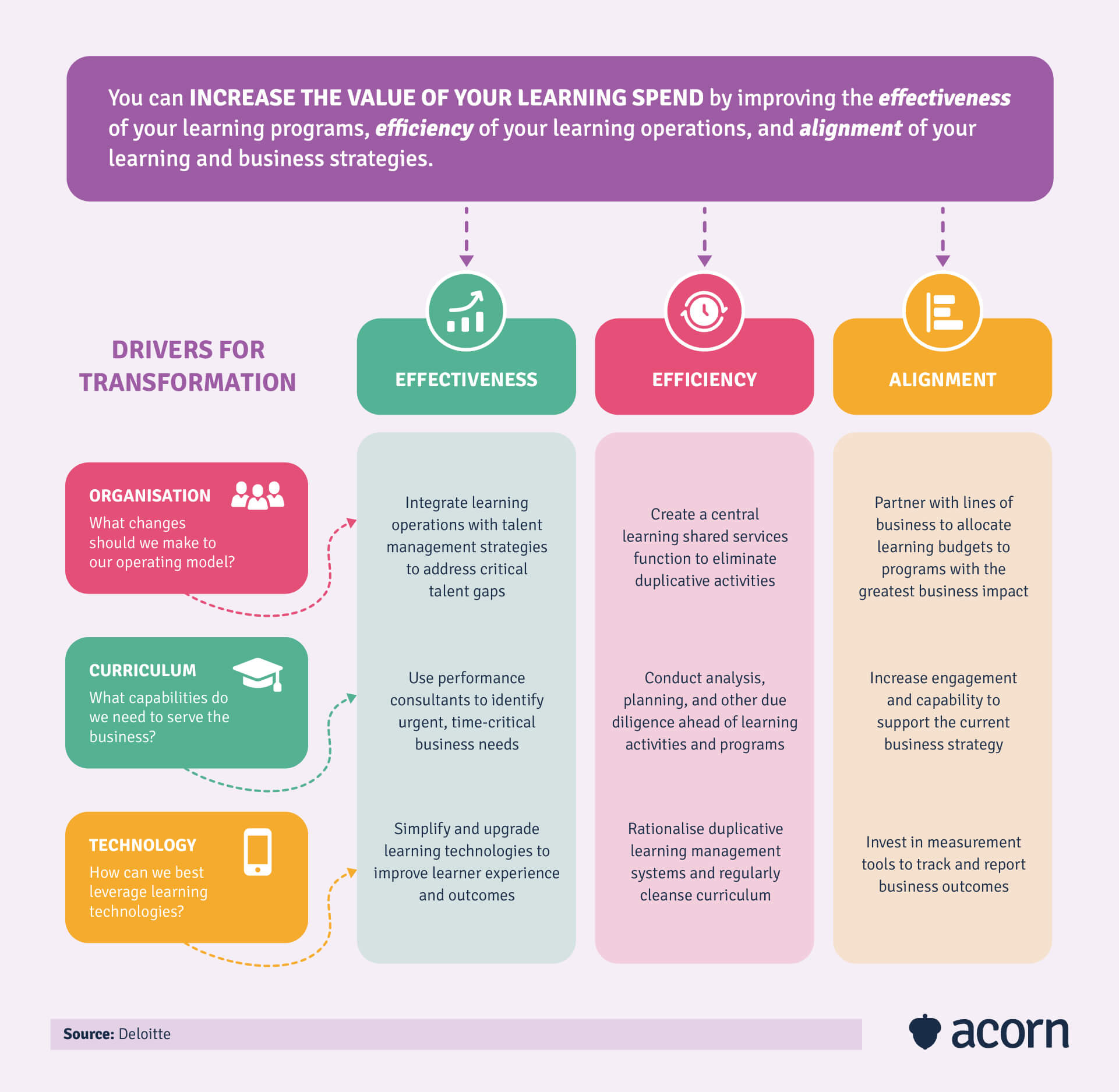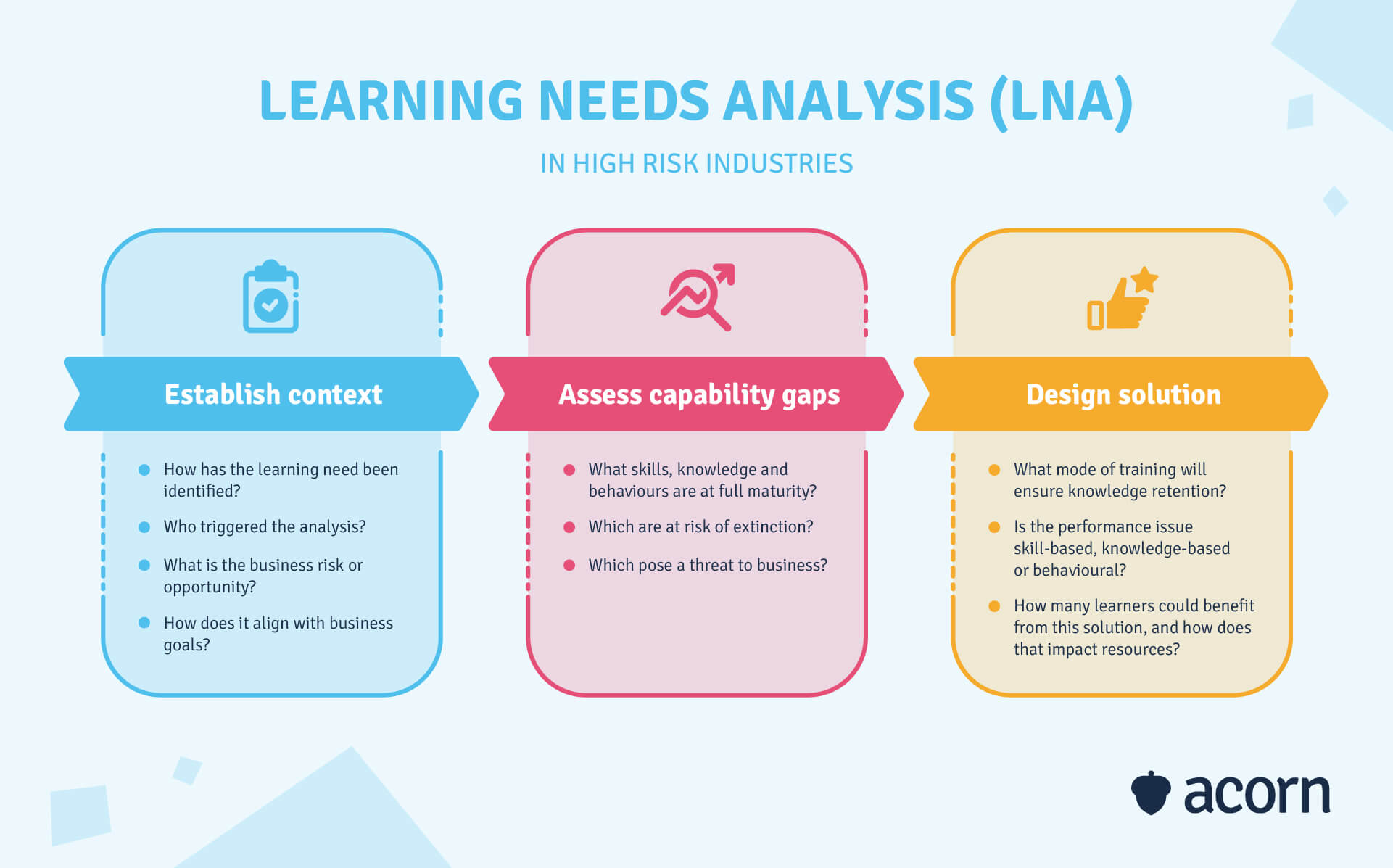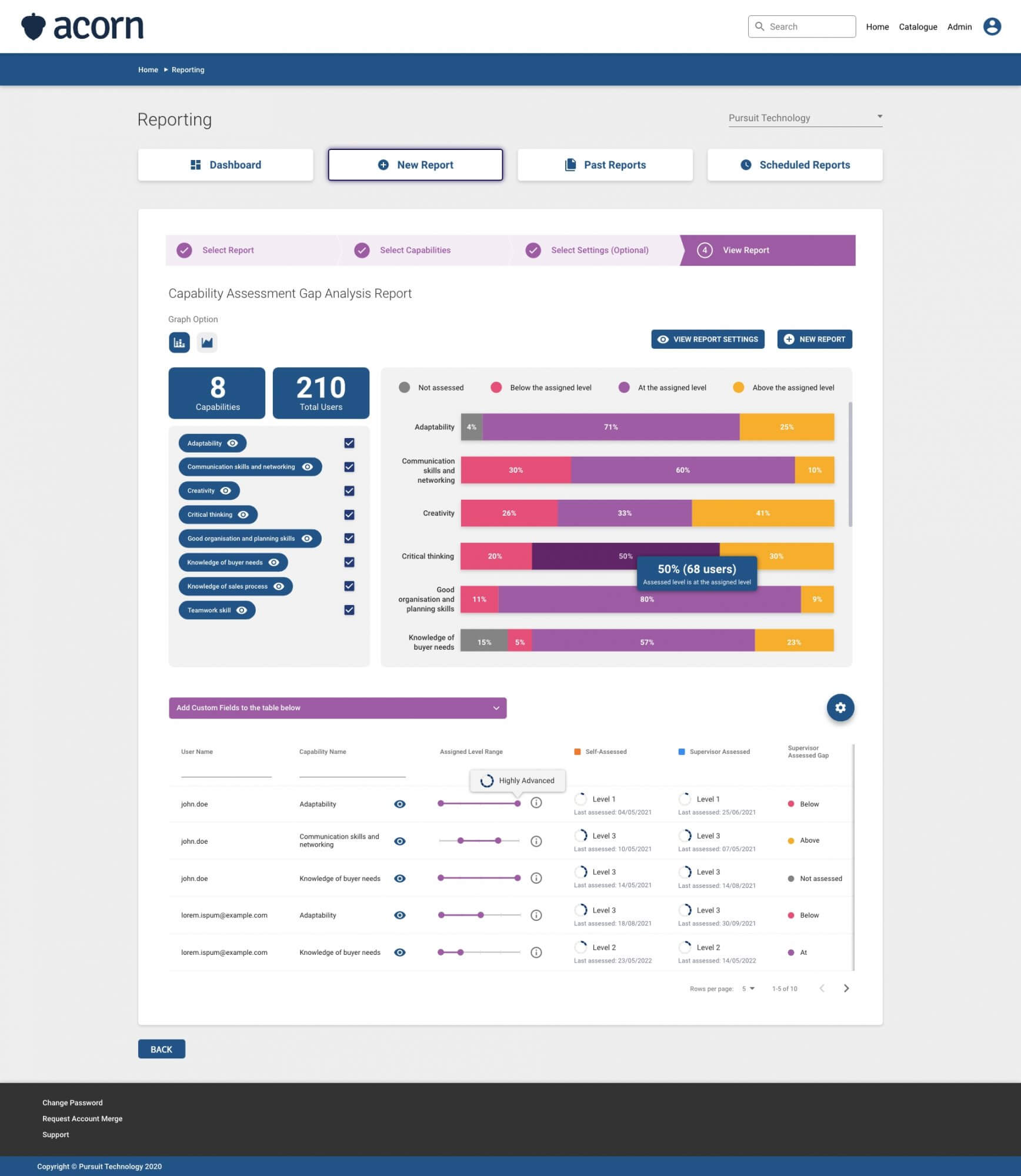A Step-by-Step Guide to Conducting a Learning Needs Analysis
Reading Time:

Lead the pack with the latest in strategic L&D every month— straight to your inbox.
SubscribeA learning needs analysis helps you understand the capability gaps of your workforce to better design capability building programs.
If you replace “needs” with “gaps”, we actually have a better starting point for talking about the learning needs analysis.
Think of it as an exercise in understanding two things.
- The gaps in employee performance affecting delivery of business strategy.
- How your learning strategy and methodology supports both employee and business performance.
We include a step-by-step learning needs analysis example in this blog, as well as the impact of incorporating it into your learning strategy and the different types of needs analyses you can do. Let’s dive in.
What is a learning needs analysis?
A learning needs analysis is a structured process that assesses what knowledge, skills and behaviours are necessary to perform effectively in a job role. The aim is to find gaps in performance, as aligned with business needs, and map those gaps to the right training.
Learning needs analysis vs training needs analysis
While used interchangeably, these two types of needs analyses have different focuses.
- A learning needs analysis looks at learners and the capability gaps around them.
- A training needs analysis considers training programs and how they do or don’t meet company goals.
The importance of a learning needs analysis
Let us hit you with some facts first.
- According to a Deloitte survey, 62% of organisations don’t know exactly how much they’re spending on learning.
- The same survey found only 21% of organisations rate themselves as at least good on learning ROI.
- Harvard Business Review found just 12% of employees apply new skills to their job post-training.
Traditionally, many training initiatives have taken a one-size-fits-all approach to learning that directly contrasts the unique combination of skills, behaviours and knowledge required in each job role in your workforce. And that approach flies right past an integral part of learning design: Purpose.
And while traditionally you could depend on rudimentary L&D metrics (like CPD) because industry thinking skewed that way, there’s no excuse for future L&D to not be strategically aligned with business performance. This is why we created the first performance learning management system (PLMS) here at Acorn—to ensure learning is aligned with business strategy in order to drive organisational efficiency.

Without business alignment, ROI is hard to determine since you can’t show the business value of employee training, investments are even harder to justify since budget visibility is likely low or decentralised, and employee engagement will be impacted by learning the wrong thing, for the wrong reasons, at the wrong time, and with no context or support for realising new skills.
Lacking a continual flow of meaningful data (which needs analyses provide) means you can only chase reactive, short-term wins. A chaotic learning landscape will catch your organisation off guard in times of economic uncertainty when L&D is meant to be a vanguard of agility and adaptability.
The result? L&D is seen as a cost centre and we’re back at fact #1.
Proactive vs reactive needs analysis
The other part of the learning needs analysis is taking either a proactive or reactive approach.
- The trigger for a reactive needs analysis would involve a training request from a department head, who has self-identified a performance issue, that L&D then fulfils.
- A proactive needs analysis sees L&D undertake a gap analysis to identify high priority training needs, based on business strategy.
It’s harder to prove impacts from a reactive needs analysis, given the insular view of the request (through no fault of the department head, mind you). Even if L&D has time to perform their own needs analysis, it’ll still be unclear if fixing this performance issue will enact any business results. That means justification of expenses isn’t easy, and we’re back to our earlier points.
In saying that, reactive training is hard to avoid altogether as it’s still necessary at times. But the clear benefit of the latter is L&D can verify business impact and value, considering a proactive training needs analysis is informed by organisational strategy.
How do you perform a proactive learning needs analysis?
You shouldn’t be waiting for specific requests to do a needs analysis, not if you really want to align L&D as a business partner. The aim is to uncover high-risk gaps that threaten or unexploited opportunities that improve business performance.
The biggest step in a proactive analysis is data collection and analysis. The main takeaway is finding the root cause to a performance issue, so we recommend a three-pronged approach.
- Capability discovery
- Capability assessment
- Development plans.
1. Capability discovery
Part of the puzzle for L&D is predicting what capabilities will be needed in future, how technology will evolve, and how both of those will impact ways of work.
Capability discovery is the process of defining and mapping capabilities to job roles. You can utilise a digital discovery tool for this or aggregate data from employee questionnaires and self-assessments to understand the day to day.
The idea is to understand what capabilities are appropriately mapped to roles and what is not working, under-utilised or poorly executed, thereby creating a risk. For example: Leadership capabilities may not accurately match the challenges your leaders are facing, creating a disconnect between the role description and the reality of work. Because systemic performance evaluation is tied to the description, work may not be meeting strategic outcomes on paper.
2. Capability assessment
When you’ve uncovered potential priorities, next step is to understand capability maturity. This gives you a basis for the depth and breadth of training program needed.
You’re looking at the level of competency or proficiency to which a capability is performed (which, again, gives you better insight for creating impactful development plans). This is beneficial for a proactive analysis as it can:
- Highlight emerging gaps in succession plans
- Uncover hidden talent to better enable talent mobility (and lower recruitment spend)
- Expose ill-defined job roles or KPIs
- Diagnose specific gaps, making for more accurate resourcing.
3. Development plans
This is where you can flesh out a business case to take to people leaders. Most learning initiatives go unclaimed by employees because of something called the intention-behaviour gap, aka the gap between learners intending to undertake training and the reality of them completing it. Think New Years’ resolutions, for a sobering example.
So, in creating learning programs to convince stakeholders of the urgency of a defined learning need, you must prove that learning will be intentional.
Ergo, it’s easier to sell development to both people leaders and employees through a proactive approach, since:
- They are truly “personalised”. The nuance provided by the level of competence shows employees the tangible impact of L&D.
- Learning content, given the right technology, can be mapped to specific capabilities and competency levels.
- You can link performance improvements back to business strategy (through capabilities, you know).
How do you perform a reactive needs analysis?
Consider a reactive learning needs analysis a diagnosis. Very often, the perceived symptom is not the root cause of a performance pain point.
That gives you a few steps to work through for a learning request.
- Establish organisational context
- Assess capability and competency gaps
- Map learning need to solution.

1. Establish context
Always start with business goals and strategy, even when focusing on learners’ needs and especially when taking a proactive approach.
Understanding organisational context means asking and answering a few questions.
- What is the intent of the learning need?
- How has it been identified?
- What is the risk to the business?
- How would a learning solution align with business goals?
The idea is to understand the environment in which the learning need or performance issue exists, in order to paint a clear picture of how work gets done. Say you’ve had a request from the sales team lead as they need an emerging leader to develop their communication skills. Consider:
- The urgency of the succession plan. Would a critical role in your value chain be left vacant if the emerging leader didn’t undertake a learning program within a certain timeframe?
- The environment in which the learner currently works. Is it set up to support post-training enablement?
- The learner’s current job role. Has there been an error in how their job description has been created, in terms of capabilities?
- The relationship between this learning solution and business priorities. Perhaps the sales department thinks the role would be a critical vacancy, but capability heatmaps say otherwise.
At this stage, you’re not just assessing urgency and priority re: business goals. You may find that training isn’t required to address a problem (rather, recruitment or a change in processes), negating the need to spend time and money on a program at all.
2. Assess capability gaps
Whether you go for a skills matrix or capability assessment, the key here is to identify gaps in required knowledge, skills and behaviours.
You want clear, verifiable data so we’d still recommend the latter, as it gives you better groundwork to define training goals from a learning need. Part of the advantage is that every capability comes with its own core competencies, aka a definitive measure of performance. This gives an added layer of alignment when it comes to designing or assigning a training program.
Some tools to gather data here include:
- Capability self-assessments. Additional benefit of giving employees a reason to buy into strategy-led L&D through engagement and autonomy.
- Manager performance evaluations. This’ll provide a more objective view of current performance issues.
- Heat maps. Especially if you’re assessing prioritisation of a learning need, capability heat maps will show the proximity of said need to business outcomes.
- Learning progress. Learning data is most helpful if you already map capabilities to content, and also define capabilities by levels of complexity and competence. It’ll make it easier to identify current areas of business risk, though it’s not a leading indicator for a proactive analysis.

3. Map learning to need
This isn’t just about designing your own program, but optimising your learning strategy. A learning needs analysis is about diagnosing issues with employee performance in order to mitigate business risk—or exploit business opportunities.
Capability building initiatives should change how work gets done to help inform better performance interventions for reactive needs and strategic training for proactive analyses.
Consider not just skills, but behaviours and experience when matching training and learning need. Experiential learning, like stretch assignments, have greater knowledge retention (and therefore business impacts) in the long run. Josh Bersin says this is because the learning solution is aligned with how things work in your company and learners get the immediate gratification of meaningful results.
It’ll also pay to understand if individual learning is worth it, or if you need to take a more birds-eye view. A Pareto Principle approach could offer bigger bang for your buck for a high-risk learning problem, particularly when research shows you only need to train 25% of your workforce to create enough change agents for deeply embedded behaviours to change.
Examples of learning needs
Remember when we said a needs analysis gets you to the root cause of a performance problem? There are a few types of issues that an analysis may throw up.
- Performance. Wherein a skills gap is identified and the training required focuses on closing said gap in a reasonable amount of time. It’ll also be more closely tied to competency than other identified needs
,and will likely require you to think more about learning styles.
- Job role. This looks at the reality of tasks and how work gets done in the day to day. May emerge as the pain point for first-time managers or newly created roles, as examples.
- Organisational. More commonly seen in a training needs analysis, but still a need to consider since all training leads back to the organisation. Development programs here would link to a specific business problem rather than one employee’s learning needs, such as capacity building.
- Training. Again, this is its own type of analysis, but one that’s still rather co-dependent with learning. If a learning needs analysis shows that really training efficacy is the problem, you’ll like need to investigate your methodology.
Key takeaways
A learning needs analysis shouldn’t be a daunting task, but it should be one you undertake proactively and consistently.
Think of a needs analysis as the process of building a business case for a training initiative.
It asks you to look at how capabilities are currently mapped to your job roles, what’s at optimal maturity, what needs to be created or developed, and the best solution for those gaps. All information that’ll show L&D’s got their finger on the pulse of business strategy.